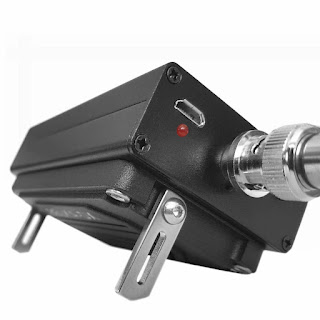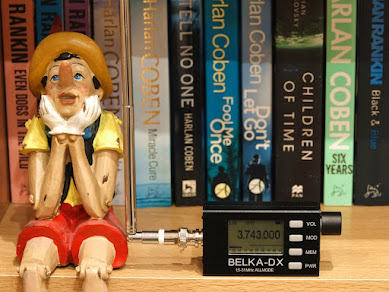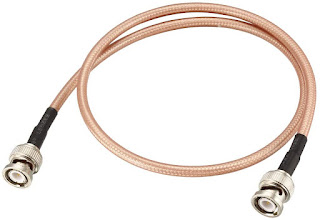The smart steel case provides good RF shielding and a solid foundation for the popular BNC socket. Adjacent to the antenna socket is a headphone jack and a micro-usb charging point for the internal 2200mAh Lipo. On the opposite end of the case is the tuning knob and a stereo jack for the IQ-Out.
I collected the radio from the Post Office Hub (I'd missed the delivery) and inside the box was the radio, a telescopic whip and that's it!! No leads, no instructions. The dimensions of this matchbox-size radio really strikes you (pardon the pun). It's tiny! But boy, it feels and looks great. It oozes quality despite being so cheap to purchase.
The first thing I did was stick the telescopic whip on it and switch it on. The device had been left on Shanon Volmet frequency 5.505 and the signal was amazingly loud and clear - and I was sat inside my car!! A good start. When I arrived home, I put the Belka DX next to my trusty old AOR AR3000A. Switching between the two on a shared antenna showed no difference (apart from the fact that the 3000 was ever so slightly off frequency (but she is 30yrs old)).
The display (despite being small) is fantastically clear - it makes the AR3000A look terrible. You can choose to have it backlit or not and there is full adjustment for brightness and contrast. At the bottom of the screen is the signal strength meter which provides a reading in 'dBµv/EMF' which is gobbledygook to me, but roughly converted means halfway along the scale is S9.
Tuning around using the external antenna showed that not only had the Belka DX got superb sensitivity, but it also coped perfectly well with big signals, showing almost no signs of overloading. This surprised me considering how good it was on the telescopic. The AR3000A for example, needs to be physically attenuated when connected to an outdoor antenna. Image rejection is over 70 dB, better than an Elecraft KX3 according to F6DFZ's measurements.
Speaking of attenuators, the Belka DX doesn't have one. And neither does it have a PreAmp. But what it does have (which I prefer) is an RF GAIN adjustment. Well actually, they call it a 'Sensitivity' slider. It's a very handy tool and something I use all the time to hear better (usually by turning it down slightly).
As you can see from the image below, the Belka is even smaller than a little RSP1A and it's absolutely dwarfed by my Tecsun 😂
The Belka DX that I purchased included the optional loudspeaker. It's not very loud, but it's fine indoors or in a fairly quiet outdoor environment. You can, of course, attach an amplified external speaker if you so wish. Probably better to use earphones (use a stereo jack or you will damage the radio). Choosing earphones with a long length of wire will assist reception by acting as a counterpoise.
There is a 3rd party speaker option on the market, which includes a pair of neat folding legs which put the Belka at a good viewing angle on a table, but to me, this option just adds too much bulk and detracts from one of the radio's biggest attractions - its tiny size!
 |
| LS3PW - Optional 3rd-Party speaker bolt-on |
The ergonomics of the Belka have been criticised by some, but honestly, there's nothing wrong. Without reading the manual, I was able to do everything I wanted and very quickly found 'hidden' menus/options. If you are used to modern radios, it will all come easy to you.
The radio has 32 memories and I used these to store the start-frequencies of all the HAM bands, before adding a few other favourites. It makes it so easy to get where you want to be. The VFO knob is the perfect size for the radio and it feels like it's going to last forever.
I can't wait to take this out with me and throw a length of wire into a tree. Having said that, I feel that the telescopic will be good enough on its own, especially if I'm outdoors in a slightly elevated location.
Above you can see the Belka being used outside in the garden with a mini-tripod (it's just easier to handle the radio without an antenna attached) and a recorder plugged into the IQ out socket.
The BELKA DX is just an awesome bit of kit. I'd say it's more for the HAM fan than the traditional SWL fan, since it doesn't include LW or MW. That is a shame but the HF coverage, SSB and CW modes, filters, stability, frequency accuracy and overall performance make up for it. I think everyone should have one of these. Just stick it in your pocket wherever you go.
BELKA-DX DSP TECHNICAL SPEC
-Frequency range 1.5MHz - 31MHz
-Modulation modes CW, SSB LSB,NFM,AM1 and АМ2 (pseudo-synchronous).ALL MODE
-Frquency step 10, 20, 50, 100 Hz; 1, 5, 10, 50 kHz.
-Adjstuble bandwith, low and high skirts 2-4kHz; 50 - 300Hz.
-CW mode bandwith ~300 Hz; Adjustable CW pitch 500-1kHz.
-Receiver front-end is optimised for using telescopic antenna (800mm) in the range 1.5 - 31MHz.
-IQ output for viewing panorama on a computer
-Signal strength indicator (S-meter).
-Adjustable receiver sensitivity.
-Image rejection ~70dB.
-Timeout timer (TOT).
-Battery level indicator.
-Dial lock state indicator.
-Mode (modulation type) indicator.
-32 memory locations.
-Built in audio power amplifier, designed to work with external loud speaker with impedance 4-8 ohm.
-Charge and supply from micro USB port 5V.
-Built in battery LiPo 2200 mA
-Current consumption - around 80mA. Power consumption - 0.25mW with headphones.
-Battery life - 24 hours when on headphones.
-Built-in speaker (Optional)
Mechanical data:
- Cabinet measures 84х50х20mm
Thanks for visiting the blog. Leave a message below.
73, Tom, M7MCQ.
UPDATE : 20 June 2023
Yikes, the prices have shot up!!












5 comments:
Fantastic blog!! Lots to read up on, for a new chum like me! Thanks.
I just have a Hakr One and Portapack and a R82082 Dongle and two other dongles... a USB driven CCUPC and a USB driven CC Preamp with the SDR Sharp platform. Having a few issues reloading the downloads though. Also have a receiver only Yaesu FRG 7 borrowed from my brother ZL1DAI . Expecting my license in the post Monday or Tuesday. Cheers and 73s
Hi there and THANK YOU for visiting my blog. It sure is nice to hear that people are getting something from it.
When your license arrives (congratulations), be sure to register on QRZ.com with all your details. Your Noel's QRZ record has virtually no information on it.
Have fun with the hobby and maybe we'll speak on-air sometime :-)
73, Tom, M7MCQ.
Gracias por la exposición
This receiver is a marvel.
I acquired a used one of the very latest version (0.1 to - 31MHz) with the speaker and I can no longer do without it.
Even at home, with an EFHW 40, 20, 15 and 10M antenna, its reception is better than that of the IC-7300.
I make beautiful Dx Broadcasts with...
73
Jo - F5NFB
I agree with you Jo. Sadly, mine has just started to develop a screen fault - it doesn’t affect the receiver obviously, but it’s a little disappointing. Might be a reason to upgrade to the 0.1MHz version :-)
Thanks for visiting!
73, Tom, M7MCQ.
Post a Comment